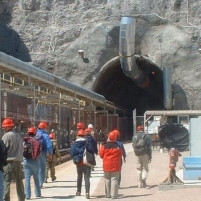What Should We Do with America’s Nuclear Waste?
Friday, March 25, 2011
 Yucca Mountain, North Entrance (photo: Daniel Mayer)
Yucca Mountain, North Entrance (photo: Daniel Mayer)
Nuclear waste from nuclear power plants has been piling up across the United States since the Eisenhower administration—a problem that politicians have failed to permanently resolve and must again address in the wake of Japan’s radiation nightmare from the damaged Fukushima plant.
Like the leaking facility on the east coast of Japan, American nuclear plants have been “temporarily” storing spent fuel rods in special pools while the federal government worked on a better plan for long-term disposal. But after more than 60 years of nuclear power, the U.S. has no way of permanently storing its toxic leftovers for the thousands of years it will take for the waste to stop being so deadly.
U.S. Representative John Dingell (D-Michigan) has called the nuclear-waste situation “an unholy mess.” At many sites throughout the country, the holding pools contain twice the number of spent rods that were originally intended, creating even greater potential for Fukushima-like crises on American soil.
One interim fix offered by scientists and engineers is to store the rods in dry casks, which some power plants are already doing. This method involves lowering a steel box into a spent fuel pool, placing the fuel inside the box, draining it of liquid and then pumping it full of an inert gas to prevent rust. The box is then placed in a concrete-and-steel sleeve on a concrete pad surrounded by barbed wire, closed-circuit cameras and security guards.
But this solution isn’t considered sufficient for long-term disposal. That’s what Yucca Mountain in southern Nevada was supposed to be, until President Barack Obama sided with Nevada officials and environmentalists in shutting down the three-decade project before it could move another step closer to completion.
Many Republicans and Democrats in Congress are calling for Obama to restart Yucca Mountain. But the reality is that even if the president changed his mind, the repository wouldn’t be operational—meaning ready to accept the first of the 65,000 tons (and counting) of spent nuclear waste—for another 10 years.
-Noel Brinkerhoff
Japan Nuclear Crisis Revives Long U.S. Fight on Spent Fuel (by Matthew Wald, New York Times)
U.S. Nuclear Waste Problem Gains New Scrutiny (by Ralph Vartabedian, Los Angeles Times)
Obama Administration Withdraws Plans for Yucca Mountain Nuclear Dump (by Noel Brinkerhoff, AllGov)
- Top Stories
- Unusual News
- Where is the Money Going?
- Controversies
- U.S. and the World
- Appointments and Resignations
- Latest News
- Musk and Trump Fire Members of Congress
- Trump Calls for Violent Street Demonstrations Against Himself
- Trump Changes Name of Republican Party
- The 2024 Election By the Numbers
- Bashar al-Assad—The Fall of a Rabid AntiSemite






Comments